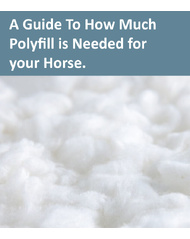Horse Rug Insulation Guide: Choosing the Right Polyfill Weight

Understanding Polyfill in Horse Rugs: What It Is and Why It Matters
When it comes to keeping your horse comfortable and protected during the colder months, the type and amount of insulation in their rug can make all the difference. One of the most common materials used for thermal insulation in horse rugs is polyfill—but what exactly is it, and how does it work?
What Is Polyfill in Horse Rugs?
When winter hits, a properly insulated horse rug can make all the difference. One of the key components of a Delzani winter horse rug is the polyfill lining—a lightweight synthetic fibre designed to retain warmth by trapping heat in tiny air pockets.
Much like insulation in your home, polyfill helps regulate body temperature by reducing heat loss. The thicker and denser the fill, the better its insulating performance.
Understanding Polyfill Weights: What Does 100g, 200g, or 300g Mean?
The weight of polyfill is measured in grams per square meter (gsm). This isn’t the total weight of the rug—but the density of insulation used throughout.
- 100g Polyfill = Light warmth
- 200g Polyfill = Medium warmth
- 300g Polyfill = Heavy warmth
The higher the number, the more body the insulation has, and the more warmth it will provide.
Choosing the Right Fill Weight
Selecting the appropriate polyfill weight depends on a few key factors:
- Climate: In milder regions, a medium-weight rug (around 200g) may be sufficient. In colder areas, especially during deep winter, a heavy rug (around 300g) offers better protection without the need for multiple layers.
- Horse’s Coat Condition: Clipped horses or those with finer coats typically require more insulation.
- Age and Health: Senior horses or those with health concerns often benefit from extra warmth.
- Rugging Strategy: Some riders prefer using a single heavy rug, while others layer under rugs beneath a medium-weight turnout for adjustable warmth.
Understanding Quality Differences in Polyfill
At Delzani, we carefully source high-quality polyfill with excellent loft recovery and long-term durability. Lower-cost polyfill—often sourced from inferior suppliers—can compress quickly, reducing insulation performance over time. Even a 300g rug made from poor-quality polyfill may perform like a 200g rug from a superior manufacturer.
Compression and Longevity
Over time, all polyfill will experience some compression, especially with frequent use. As the fill flattens, its ability to trap air diminishes, reducing insulation. This is why some horse owners prefer a 300g fill—it maintains a higher level of warmth for longer, even as the fill begins to settle with use.
Medium vs. Heavy Fill Rugs
Medium Weight (Polyfill: 200grm)
- Best for: Transitional weather or warmer climate winters
- Specifics: Offers good insulation without overheating and can be paired with under-rugs as needed.
Heavy Weight (Polyfill: 300grm)
- Best for: Cold climates or clipped horses
- Specifics: Often sufficient on its own without requiring layers, offering simplicity and time savings.
Polar Fleece vs Polyfill: What’s the Difference?
Some turnout rugs feature polar fleece lining instead of polyfill. While polar fleece adds light warmth and excellent moisture-wicking, it cannot match the thermal retention of a true 200g or 300g polyfill rug.
Use polar fleece rugs when:
- Your horse is warm-natured
- You’re bridging the gap between seasons
- You want to wick away moisture under a rain sheet
Should You Choose 200g or 300g?
Both have their place:
- Go with 200g if you want more versatility and plan to layer
- Opt for 300g if you prefer one-and-done warmth and live in cooler regions
Compression is also a factor: heavier fills maintain their structure better across the season, meaning 300g rugs will hold warmth longer without becoming flat and ineffective.
Delzani’s Recommendation
If you’re looking for the best winter horse rugs in Australia, Delzani’s Winter Turnout Range is engineered for performance, comfort, and durability.
- Montana 'Mid' (200g): Ideal for moderate winter use across most of Australia
- Denver 'Heavy' (300g): Designed for deep winter warmth, no underrugs needed
Explore the Delzani Winter Rug Collection [Link here]
Don’t Just Look at Numbers—Look at the Horse
Remember, horses—like people—acclimate to their environment. A 300g rug might be perfect for a Queensland horse in winter just as it would be for one in Victoria. What matters most is your horse’s comfort, coat condition, and how early or late in the season you begin rugging.
If you’re unsure whether a 200g rug will be too warm, consider starting with an unlined rain sheet and layering with under rugs as needed. This offers more flexibility to adjust insulation levels based on fluctuating temperatures.
Leave a comment
Related Equestrian Guides
Equestrian Breeches & Tights - Washing Guide
Our horse riding jodhpurs and equestrian tights are designed to work hard.
A guide to seat grips on our Breeches & Tights
It is interesting to learn how silicone is applied to breeches. Silicone is applied much like screen printing and there can be anywhere from 3 to 10 layers - building up the silicone. The number of layers affects the long-term quality.
Learn more about our breeches & tight fabrics
At Delzani - we pride ourselves on the careful in house selection and development of our premium breech and tights fabric blends. Each fabric has been researched and custom made to meet our requirements and the needs of Australian equestrian riders.
Dress for Success - Dressage Dress Code
Want to look your best at your next Dressage Event but not sure what the rules are? Understanding exactly what is and isn’t permitted in regard to dress standards for dressage riders can be very helpful when putting your competition wardrobe together.
Dress for Success - Showjumping Dress Code
Understanding exactly what is and isn’t permitted in regard to dress standards for Showjumping competitors can be very helpful when putting your competition wardrobe together.
Choosing the prefect horse riding sock
Delzani horse riding socks are designed to help support equestrian enthusiasts optimise performance. Our expert designers intuitively understand the needs of Australian horse riders. We outline the nuances to help Equestrians find their perfect pair.
Waterproof Horse Rugs & Winter Turnouts
Keep your horse cozy and dry during rainy and cold winter weather with Delzani's waterproof turnout horse rugs. Designed for comfort and warmth, our rugs provide reliable protection against harsh weather conditions. Shop now!
How to fit & adjust horse rug belly surcingles
We explore some of the common questions regarding belly surcingles; what do they do and how to ensure the fit is correct for ideal comfort, safety and horse rug longevity.
How to maintain your saddlery leather
Cleaning tack is admittedly not something we like to spend our spare time engaged in, but it is necessary nonetheless and a little knowledge can go along way to get the best life from your leather.
A Guide to Delzani Horse Rug Fabrics
Managing and Preventing Queensland Itch in Horses
Banish the Itch: Managing and Preventing Queensland Itch in Horses

















